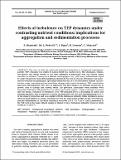Por favor, use este identificador para citar o enlazar a este item:
http://hdl.handle.net/10261/15761COMPARTIR / EXPORTAR:
 SHARE SHARE
 CORE
BASE CORE
BASE
|
|
| Visualizar otros formatos: MARC | Dublin Core | RDF | ORE | MODS | METS | DIDL | DATACITE | |

| Título: | Effects of turbulence on TEP dynamics under contrasting nutrient conditions: implications for aggregation and sedimentation processes |
Autor: | Beauvais, S.; Pedrotti, M.L.; Egge, Jorun Karin; Iversen, K.; Marrasé, Cèlia CSIC ORCID | Palabras clave: | Transparent exopolymer particles TEP production Phytoplankton POC Turbulence Nutrients Aggregation Mesocosms |
Fecha de publicación: | 5-oct-2006 | Editor: | Inter Research | Citación: | Marine Ecology Progress Series 323: 47-57 (2006) | Resumen: | The effect of different small-scale turbulence intensities on transparent exopolymeric particle (TEP) dynamics was studied in natural North Sea coastal waters. The abundance, volume, size spectra and carbon content of TEP were examined in mesocosms with and without added nutrients: no addition (T series) and a Redfield ratio supply on Day 1 (NT series), fertilized with 16 μM N:1 μM P:32 μM Si to favor phytoplankton production in the form of a bloom. Turbulence was generated by vertically oscillating grids, operating continuously for 14 d. We determined whether TEP production, under contrasting nutrient conditions, changes with level of turbulence. TEP concentration increased with turbulence. The effect of turbulence was likely indirect, by inducing an increase in growth rates of diatoms that actively exude TEP precursor, particularly when nutrients were exhausted. Following TEP production, the ratio of particulate organic carbon to nitrogen increased after the bloom, regardless of turbulence level. TEP formation led to a decoupling of carbon and nitrogen dynamics, with a large flow of carbon channeled into the TEP pool, representing up to 44% of the primary production, and was constant with the turbulence intensity. While turbulence had no effect on small particles (<40 μm), turbulence favored the aggregation of TEP >40 μm. We found significant sedimentation of TEP when turbulence was lower (5 to 8 × 10–2 cm2 s–3) and a persistence of the TEP pool in the tanks without sinking at higher levels of turbulence intensity, typical of storm events (ε = 1 cm2 s–3). | Descripción: | 11 pages, 6 figures, 2 tables | Versión del editor: | https://doi.org/10.3354/meps323047 | URI: | 10261/15761 | DOI: | 10.3354/meps323047 | ISSN: | 0171-8630 | E-ISSN: | 1616-1599 |
| Aparece en las colecciones: | (ICM) Artículos |
Ficheros en este ítem:
| Fichero | Descripción | Tamaño | Formato | |
|---|---|---|---|---|
| Beauvais_et_al_2006.pdf | 393,21 kB | Adobe PDF |  Visualizar/Abrir |
CORE Recommender
SCOPUSTM
Citations
44
checked on 06-may-2024
WEB OF SCIENCETM
Citations
43
checked on 22-feb-2024
Page view(s)
316
checked on 13-may-2024
Download(s)
115
checked on 13-may-2024
Google ScholarTM
Check
Altmetric
Altmetric
NOTA: Los ítems de Digital.CSIC están protegidos por copyright, con todos los derechos reservados, a menos que se indique lo contrario.
